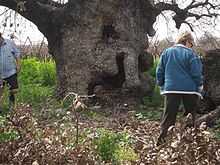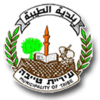Tayibe
| Tayibe | ||
|---|---|---|
| Hebrew transcription(s) | ||
| • Hebrew | טייבה | |
| • Also spelled | Tayiba (unofficial) | |
| Arabic transcription(s) | ||
| • Arabic | الطيبة | |
 | ||
| ||
 Tayibe | ||
| Coordinates: 32°16′0″N 35°00′37″E / 32.26667°N 35.01028°ECoordinates: 32°16′0″N 35°00′37″E / 32.26667°N 35.01028°E | ||
| District | Center | |
| Government | ||
| • Type | City | |
| Area | ||
| • Total | 18,662 dunams (18.662 km2 or 7.205 sq mi) | |
| Population (2011) | ||
| • Total | 38,575 | |
| Name meaning | The Goodly[1] | |
Tayibe (also spelled Taibeh or Tayiba; Arabic: الطيبة aṭ-Ṭayyibah , Levantine pronunciation: [etˈtˤɑjbe], "the kind"/"the benevolent"; Hebrew: טַיִּבָּה) is an Arab city in central Israel, 12 km (7 mi) east of Kfar Saba.[2] In 2011, it had a population of 38,575.[3] Tayibe is part of the Triangle the local area population claim that Tayibe has exceeded 44,000 residents.
History
A village called Tayyibat al-Ism was on the list of lands allocated by sultan Baibars to his amirs in 663 AH (1265–1266 CE), about five centuries after the Arab conquest of Palestine. In Mamluk times, the village name appeared on documents referring to the waqf of the mosque in Hebron.[4]
During Ottoman rule, the daftar of 1596 shows the village was under the administration of the nahiya of Bani Sab. With a population of 50 households ("khana") and 5 bachelors, all Muslim, who paid taxes on wheat, barley, summercrops (including gura, melons, beans, vegetables etc.), olive trees, beehives and goats.[5]
The French explorer Victor Guérin described it as a village south of Fardisya,[6] while in the "Survey of Western Palestine" at the end of the 19th century, Tayibe was described as: "a large straggling village on the end of a slope, principally built of stone. It is supplied by cisterns and surrounded with olives."[7]
In the 1931 census, Tayibe had 2,944 residents living in 658 houses, all Muslim. The count may have included two nearby Bedouin tribes.[8]
In 1945 the population was 4,290 Arabs, while the land area was 32,750 dunams, according to an official land and population survey. This included some nearby Arab communities.[9] Of this, 559 were allocated for citrus and bananas, 3,180 plantations and irrigable land, 23,460 for cereals,[10] while 281 dunams were classified as built-up areas.[11]
During the 1948 Arab-Israeli War, Israeli forces captured the town lands, but not the town itself. Tayibe was transferred to Israel as part of the 1949 cease-fire agreement with Jordan.[2] According to David Gilmour, "the inhabitants were furious that Abdullah I of Jordan had simply handed them over to Israel but were relieved that they were to be reunited with their land. However, the Law of Acquisition of Absentee Property, which was passed in 1950 but made retroactive, was specially devised to take care of cases like this. Although they had not moved from their village, the inhabitants were declared 'absentees' and their land 'abandoned property'. According to the villagers, they lost 8,000 acres (3,237.49 ha) of their 11,000 acres (4,451.54 ha)."[12]
Tayibe achieved local council status in 1952. In 1990, it was declared a city.[2]
Demographics


According to CBS, in 2001 the ethnic makeup of the city was 100.0% Arab (99.7% Muslim), with no significant Jewish population. In 2001 there were 15,100 males and 14,500 females. 47.5% of the population was 19 years of age or younger, 17.4% between 20 and 29, 20.3% between 30 and 44, 9.6% from 45 to 59, 2.0% from 60 to 64, and 3.3% 65 years of age or older. The population growth rate in 2001 was 3.2%.
The population of Tayibe, one of the largest and most developed Arab localities in Israel, is made up of 20 extended families, all Muslim.[13]
Education and culture
In 2001, there were 13 schools with a total enrollment of 6,970 students: 9 elementary schools (3,984 students) and 4 high schools (2,986 students). Nearly half of all 12th graders completed their Bagrut matriculation exams.
An educational empowerment project has been operating in Tayibe since 2006 to reduce the dropout rate among Bedouin students. The students receive extra help in Arabic, Hebrew, English and math, and attend special enrichment workshops in inter-personal communication. Following the success of this project, the project has been expanded to nearby Qalansawe and other Arab villages in Israel.[14]
The Tayibe Women Against Violence organization was established to work against violence in the community. The organization offers seminars and workshops that increase women's awareness of their rights and helps them find jobs.[15]
Sports
Hapoel Tayibe F.C. was a football club based in Tayibe. In 1996, it became the first Israeli Arab club to play in the top division.[16] Israeli former basketball player and current basketball coach Orna Ostfeld is the first Jewish physical education teacher to work in an Arab school in Tayibe.[17]
Landmarks


An ancient oak tree in Tayibe was declared the largest in Israel.The oak has a trunk circumference of 690 centimeters. According to local legend, there is an angel that watches over the tree and avenges any damage to it. It is said to be 1,400 years old, although this has not been scientifically proven.[18]
Notable residents
- Kais Nashef, actor
- Mahmud A-Nashaf
- Ahmad Tibi, MK, Ta'al
- Walid Haj Yahia, MK, Meretz
- Senan Abdelqader, architect[19]
See also
References
| Wikimedia Commons has media related to Tayibe. |
- ↑ Palmer, 1881. p. 193
- ↑ 2.0 2.1 2.2 About Tayibe
- ↑ "Table 3 – Population of Localities Numbering Above 1,000 Residents and Other Rural Population". Israel Central Bureau of Statistics. 2008-06-30. Retrieved 2008-10-18.
- ↑ Petersen, 2001, p.296
- ↑ Hütteroth, Wolf-Dieter and Kamal Abdulfattah (1977), Historical Geography of Palestine, Transjordan and Southern Syria in the Late 16th Century. Erlanger Geographische Arbeiten, Sonderband 5. Erlangen, Germany: Vorstand der Fränkischen Geographischen Gesellschaft. p. 141
- ↑ Guérin, 1875, p. 352
- ↑ Conder and Kitchener, 1882, p.166. Cited in Petersen, 2001, p.296
- ↑ Census of Palestine 1931. Population of Villages, Towns and Administrative Areas. Jerusalem, 1932, p58
- ↑ Government of Palestine, Department of Statistics. Village Statistics, April, 1945. Quoted in S. Hadawi, Village Statistics, 1945. PLO Research Center, 1970, p. 76
- ↑ Government of Palestine, Department of Statistics. Village Statistics, April, 1945. Quoted in S. Hadawi, Village Statistics, 1945. PLO Research Center, 1970, p. 128
- ↑ Government of Palestine, Department of Statistics. Village Statistics, April, 1945. Quoted in S. Hadawi, Village Statistics, 1945. PLO Research Center, 1970, p. 178
- ↑ Walter Schwarz: The Arabs in Israel Faber & Faber, London 1959, p. 40, and Israel and Palestine, No. 51 (August 1976), p.1. Quoted in Gilmour, 1983, p. 106
- ↑ Effects of consanguineous reproductive outcome in an Arab community in Israel
- ↑ Alkhaimah- Association for Education & Development
- ↑ Tayibe: A dream came true
- ↑ It's a level playing field, Haaretz
- ↑ Electra Ramat Hasharon. "Staff – Orna Ostfeld". Rhbb.org.il. Retrieved November 5, 2011.
- ↑ Lightning strike brings new fame to giant old oak tree. Haaretz.
- ↑ A jump start for Palestinian architecture – Haaretz – Israel News
Bibliography
- Conder, Claude Reignier; Kitchener, Herbert H. (1882). The Survey of Western Palestine: Memoirs of the Topography, Orography, Hydrography, and Archaeology 2. London: Committee of the Palestine Exploration Fund.
- Gilmour, David (1983): Dispossessed. The Ordeal of the Palestinians. Sphere books, Great Britain, ISBN 0-7221-3842-3
- Guérin, Victor (1875). Description Géographique Historique et Archéologique de la Palestine. Vol 2; Samarie, pt. 2.
- Hadawi, Sami (1970), Village Statistics of 1945: A Classification of Land and Area ownership in Palestine, Palestine Liberation Organization Research Center
- Hütteroth, Wolf-Dieter; Abdulfattah, Kamal (1977). Historical Geography of Palestine, Transjordan and Southern Syria in the Late 16th Century. Erlanger Geographische Arbeiten, Sonderband 5. Erlangen, Germany: Vorstand der Fränkischen Geographischen Gesellschaft.
- E. Mills, ed. (1932). Census of Palestine 1931. Population of Villages, Towns and Administrative Areas. Jerusalem: Government of Palestine.
- Palmer, E. H. (1881). The Survey of Western Palestine: Arabic and English Name Lists Collected During the Survey by Lieutenants Conder and Kitchener, R. E. Transliterated and Explained by E.H. Palmer. Committee of the Palestine Exploration Fund.
- Petersen, Andrew (2001), A Gazetteer of Buildings in Muslim Palestine: Volume I (British Academy Monographs in Archaeology), Oxford University Press, pp. 296–298, ISBN 978-0-19-727011-0
External links
| |||||||||||||||||||||||
